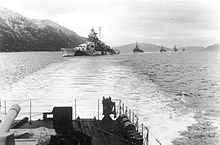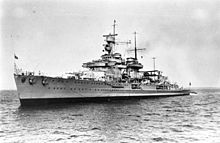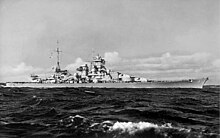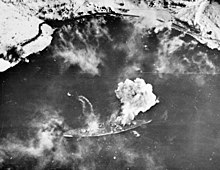Combat group (Kriegsmarine)

The combat group (from July 1944: 1st combat group ) was an association of the Kriegsmarine , which consisted of several heavy units. It was set up in February 1943 and existed until October 1944.
background
On January 6, 1943, Hitler had a discussion with the Commander-in-Chief of the Navy, Grand Admiral Erich Raeder , in which he massively criticized the previous naval warfare and, in particular, the unsuccessful use of the heavy units despite the high expenditure of personnel and material. Hitler asked the High Command of the Navy to prepare for the decommissioning of all large surface units. At the same time he commissioned Raeder to present his position on this question in a memorandum. As a result of Hitler's criticism, Raeder resigned and was replaced by Karl Dönitz on January 30, 1943 .
Although Donitz, unlike his predecessor, was not a fan of large ships, he considered the order in its absolute wrong. He succeeded in reaching a compromise with Hitler to the effect that the order could not be carried out immediately and that some of the ships should remain in operation for training purposes. Among other things, he relied on Raeder's memorandum, which stated:
"The dismantling of the German core fleet (" Tirpitz "," Scharnhorst "," Gneisenau "," Scheer "," Lützow "," Prinz Eugen "," Hipper ") would fundamentally change this strategic maritime situation. For the enemy it means a success that is thrown into his lap without a fight. "
Composition of the combat group
In order to soften the decommissioning order, the naval war command developed the plan for a training association, which should also be used for combat tasks. This should include both motor and steam- powered ships . Since no one dared to propose the receipt of battleships at first, the first plan provided for the following ships in the combat group:
- Prinz Eugen ( heavy cruiser )
- Lützow (heavy cruiser, formerly armored ship )
- Admiral Scheer (heavy cruiser, formerly ironclad)
- Nuremberg ( light cruiser )
- Emden (light cruiser)
The heavy cruiser Admiral Hipper and the light cruisers Leipzig and Cologne were to be decommissioned immediately . The battleship Scharnhorst was to be decommissioned on July 1, 1943, that of the battleship Tirpitz in autumn 1943.
In a conversation with Hitler on February 26, 1943, Dönitz succeeded in further weakening the decommissioning order and at the same time lifting the Scharnhorst ties in the Baltic Sea. This enabled him to form a combat group from the Tirpitz , the Scharnhorst , the Lützow and six destroyers , but was only allowed six months for a convincing mission in the northern area.
In fact, the decommissioning order only resulted in the conversion of the Gneisenau, which had been decommissioned since the summer of 1942, to be finally stopped. The Admiral Hipper and the Köln were decommissioned in February 1943, but reactivated as training ships in March 1944. Of the remaining ships, some were always used as training ships in the Baltic Sea. The actual combat group therefore only had a few large combat ships and a few destroyers.
Commander
The office of the commander of the combat group (BdK) emerged from that of the previous commander of the cruisers and was directly subordinate to the fleet command, which was merged with the naval group command north in March 1943 . The post of the BdK was held by the following officers:
- Admiral Oskar Kummetz (February 1943 - February 1944)
- Rear Admiral Erich Bey (representing November - December 1943)
- Captain Rolf Johannesson (entrusted with running the business February - June 1944)
- Rear Admiral Rudolf Peters (June - October 1944)
Tasks and missions
tasks
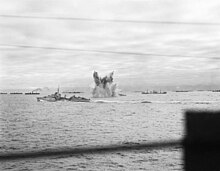
The task of the combat group was to combat allied arctic convoys and defend against enemy landings in Norway . In addition, there were the training tasks that had to be performed by some of the larger ships. After there had initially been differences of opinion between the naval war command and the naval command about the priority of these tasks, the naval war command finally made it clear that the fight against the convoys had priority over the defensive task.
Conditions of use
Until January 6, 1943, Hitler had reserved the use of the larger units in order to reduce the risk of spectacular losses. This so-called risk linkage, which had contributed significantly to the inaction of the fleet, no longer existed since the planned decommissioning and scrapping of these ships. Hitler agreed on February 9, 1943, to use these ships regardless of such ties. Accordingly, on February 15, 1943, the fleet command submitted operational plans for the battleships, which were scheduled to be decommissioned during the course of the year.
Since the Navy did not have its own air force, it was dependent on the support of the Luftwaffe for extensive reconnaissance , whose Air Fleet 5 (Colonel General Stumpff ) was responsible for the airspace over Norway and the northern sea areas. When coordinating with the Air Force, there was jealousy regarding the conduct of the operation. The air force demanded that the navy should bind the opposing naval forces in order to destroy even the important targets, i.e. allied convoys. The Navy would not be satisfied with such a role and would lead the decisive blows itself. Also, with the Air Force and Navy suffering from fuel shortages alike, it was even more difficult to agree on an approach to the same goal. Since the Air Force was only willing to fly long-distance reconnaissance at sea irregularly and only if there were concrete indications, the chances of the Navy to operate successfully against convoys were slim from the start.
1943
For these reasons, the deployment of the combat group was delayed. In fact, she was a fleet-in-being , which did not correspond to the role envisaged by the naval command. From the point of view of the fleet chief, Admiral Schniewind , the fact that no Allied Murmansk escorts were found in the summer of 1943 was to be assessed as a success that justified the passive behavior of the combat group.
From the summer of 1943 the question arose as to when which ships should be relocated to home for repair work and other tasks, and how the combat group should be composed in winter and next spring. It was assumed that the heavy units would hardly be able to be used in the northern sea region during the dark season. The intention was to return the Tirpitz and the Lützow and to leave the Scharnhorst in Norway. The Lützow was later to be replaced by the Prinz Eugen . While the Lützow began marching home in September 1943, the Tirpitz was not to follow until mid to late October.
Because no suitable targets could be found by September 1943, it was decided to advance to Svalbard , where Allied facilities were attacked. In this operation "Sicily" under the leadership of the BdK, Admiral Kummetz, with the Tirpitz , the Scharnhorst and nine destroyers , 349 different facilities were destroyed by fire and landed troops of a battalion of the Grenadier Regiment.
Admiral Kummetz was granted leave of absence since no further operations were seen for the combat group during the winter. The leader of the destroyers , Rear Admiral Erich Bey, was appointed as representative. On September 22, 1943, the Tirpitz was badly damaged by an attack by British micro-submarines and could not return to Germany. Instead, she stayed in Norway for emergency repairs, but was not available for further operations. Thus, Bey's association consisted of the Scharnhorst and some destroyers, the number of which was reduced in the course of time to the five boats of the 4th Z-Flotilla ( Z 29 , Z 30, Z 33, Z 34 and Z 38). As the Allied air raid on Norway on October 4, 1943 (" Operation Leader ") shows, this association was not even sufficient for the combat group's second task, the defense against invasions in Norway.
The "Operation Leader" made it clear that the German forces in Norway were blind to Allied operations in the North Sea without extensive aerial reconnaissance over the sea. The German leadership realized that a landing in Norway was possible. This resulted in a shift in focus on behalf of the combat group, for which the invasion defense regained importance. A new assignment of the Naval War Command for the winter of 1943/44 on November 20, 1943 took this change into account. There it said:
“ The main task of the combat group is to deploy in enemy landing attempts. For this, the combat group is to be fully deployed within the scope of the possibilities arising from the situation. "
The option of using the combat group against convoys persisted, with Dönitz reserving the right to use the Scharnhorst personally. The fleet command assessed the probability of such an operation as low. Dönitz nevertheless made it clear at a commanders' meeting of the Navy on December 17, 1943 that he was determined to deploy the combat group when the opportunity was favorable. The next day, the B-Dienst reported evidence of enemy movements, and on December 22nd a convoy with around 40 ships and suspected porters was identified. Although the reconnaissance results were incomplete and the assessment of the situation by the BdK and the fleet chief were negative, the chief of the naval war command, Vice Admiral Meisel , who represented the absent commander in chief, approved the operation on December 24, 1943. In view of the importance of the Russian convoys for the enemy, Dönitz decided on his return the following day to order the use of the combat group.
Despite unfavorable conditions, the combat group ran out with the Scharnhorst and several destroyers on the evening of December 25, 1943 and attacked the British convoy JW.55B as part of the "Eastern Front" operation. There was a sea battle off the North Cape with the British battleship HMS Duke of York , the cruisers Jamaica , Belfast , Norfolk , Sheffield and destroyers. The Scharnhorst was sunk with the embarked BdK, Rear Admiral Erich Bey .
1944
After the sinking of the Scharnhorst , the combat group consisted only of the Tirpitz, which was not ready for action, and the five destroyers of the 4th destroyer flotilla. On March 1, 1944, Admiral Kummetz was transferred as Commander-in-Chief to the Naval High Command East , and the chief of the 4th Z Flotilla, Captain Rolf Johannesson , was deployed as a representative.
Before the Prinz Eugen could be supplied as reinforcements in March as planned , the war situation on the Eastern Front had deteriorated dramatically from a German perspective. Soviet troops threatened to make a direct breakthrough to the Baltic Sea (→ Leningrad-Novgorod Operation ), which had to be prevented in any case from the point of view of the overall warfare as well as from the naval point of view. For Dönitz, the Baltic Sea was of particular importance as a training area for the submarines.
Because of the deteriorating situation, on July 17, 1944, under the name of 2nd Combat Group under Admiral Thiele, a Baltic Sea Association made up of the Prinz Eugen , Admiral Scheer , destroyers and torpedo boats was set up, which was no longer designated as the 1st Combat Group were available in the North Sea. As part of a reorganization, the 1st Combat Group was placed under the Naval Command Norway (MOK Norway) on May 1, 1944 and received a new commander in Rear Admiral Peters. After the Tirpitz was so badly damaged in another air raid in September 1944 that it was permanently out of order, the 1st Combat Group was disbanded on October 20, 1944. The remaining 4th Z-Flotilla was directly subordinated to MOK Norway.
literature
- Michael Salewski : The German naval warfare 1935 - 1945. Vol II; 1942-1945 ; Munich 1975; ISBN 3-7637-5138-6 .
- Michael Salewski: The German naval warfare 1935 - 1945. Vol III; Memoranda and situation reviews 1938-1944 ; Frankfurt am Main 1973; ISBN 3-7637-5121-1 .
Individual evidence
- ↑ a b c WLB Stuttgart
- ↑ a b Memorandum of the Chief of Naval Warfare: The Significance of the German Surface Forces for the Warfare of the Three Pact Powers of January 10, 1943. Printed in: Michael Salewski: Die deutsche Seekriegsleitung 1935 - 1945. Vol III; Memoranda and situation reviews 1938-1944 ; Frankfurt am Main 1973; ISBN 3-7637-5121-1 , p. 326 ff.
- ^ Michael Salewski: The German Naval Warfare 1935 - 1945. Vol II; 1942-1945 ; Munich 1975; ISBN 3-7637-5138-6 , p. 184 ff
- ^ A b Michael Salewski: The German Naval Warfare 1935 - 1945. Vol II; 1942-1945 ; Munich 1975; ISBN 3-7637-5138-6 , p. 225 ff.
- ↑ a b c d e Michael Salewski: The German Naval Warfare 1935 - 1945. Vol II; 1942-1945 ; Munich 1975; ISBN 3-7637-5138-6 , p. 313 ff.
- ^ Württembergische Landesbibliothek Stuttgart, Chronik des Navkriegs, September 1943
- ↑ http://www.wlb-stuttgart.de/seekrieg/43-12.htm Württembergische Landesbibliothek Stuttgart, Chronik des Seekriegs, December 1943
- ↑ Documentation on Operation Leader at Air Group 4
- ^ Württembergische Landesbibliothek Stuttgart, Chronik des Navkriegs, October 1943
- ^ Michael Salewski: The German Naval Warfare 1935 - 1945. Vol II; 1942-1945 ; Munich 1975; ISBN 3-7637-5138-6 , p. 448 ff.
